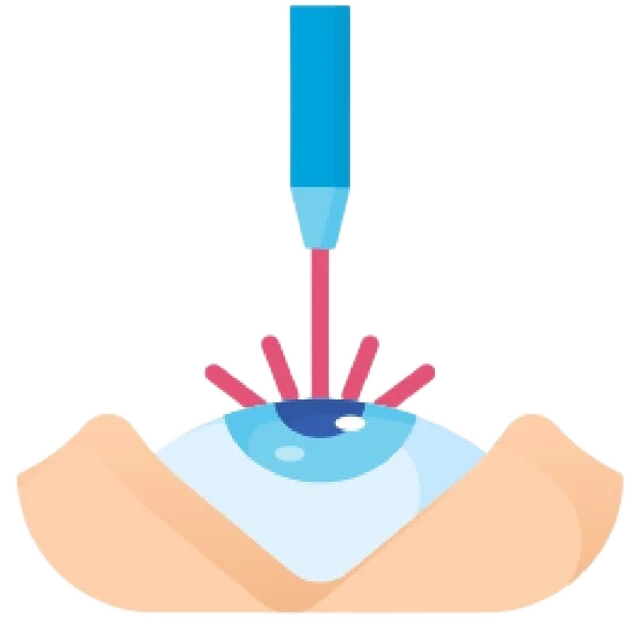
Introduction
What Is Retinal Detachment?
Retinal detachment is a serious eye condition where the retina — the light-sensitive tissue at the back of the eye — becomes separated from the underlying layer of blood vessels (the choroid) that supplies it with oxygen and nutrients. This separation disrupts visual signals and can lead to sudden, irreversible vision loss if not treated promptly.
Risk factors include ageing, severe myopia (short-sightedness), previous eye surgery (such as cataract removal), trauma, or a family history of the condition. Although less common than other eye issues, retinal detachment is considered an emergency — but with timely diagnosis and surgical repair, vision can often be stabilised or restored.
Causes and Risk Factors of Retinal Detachment
What Causes Retinal Detachment?
Retinal detachment occurs when the retina pulls away from the layer of blood vessels beneath it, cutting off its oxygen and nutrient supply. While this condition can happen suddenly, several factors can significantly increase the risk:
- Ageing – Risk increases with age, particularly in individuals over 50
- Severe myopia (short-sightedness) – Elongated eyeballs stretch and thin the retina, making it more prone to tears
- Previous eye surgery – Especially cataract surgery, which can increase the risk of retinal detachment
- Eye trauma – Direct injury to the eye can lead to retinal tears or detachment
- Diabetic eye disease – Long-term diabetes can cause scarring that pulls the retina away (tractional detachment)
- Family history – Genetic factors can predispose individuals to retinal problems
- Inflammatory eye conditions – Chronic uveitis and other inflammatory diseases may lead to retinal complications
- Tumours or vascular disorders – Rarely, fluid can accumulate under the retina due to underlying disease (exudative detachment)
Because retinal detachment is a serious condition that can lead to permanent vision loss, understanding and addressing these risk factors early is essential.
Types of Retinal Detachment
The Different Types of Retinal Detachment
Retinal detachment is classified into three main types based on the underlying cause. Identifying the type is essential for selecting the most effective treatment and predicting recovery outcomes.
Rhegmatogenous Retinal Detachment (RRD)
- Description:
The most common form, RRD occurs when a tear or hole forms in the retina. Fluid from the vitreous humour seeps through the break and lifts the retina away from the underlying tissue. - Who it affects:
Often linked to ageing, severe myopia (short-sightedness), or previous eye surgery. - Speed of progression:
Can progress quickly and requires urgent treatment to prevent permanent vision loss.
Tractional Retinal Detachment (TRD)
- Description:
Caused by scar tissue or abnormal growths on the retina’s surface that pull the retina away from the underlying layer. - Who it affects:
Common in people with advanced diabetic eye disease, previous retinal surgery, or chronic inflammation. - Speed of progression:
Generally slower than RRD, but still serious and may lead to vision loss without treatment.
Exudative Retinal Detachment
Description:
Occurs without a retinal tear. Instead, fluid leaks under the retina due to inflammation, vascular abnormalities, or tumours, pushing the retina away from its base.Who it affects:
Seen in conditions like hypertension, certain cancers, or rare inflammatory diseases.Speed of progression:
Varies depending on the underlying cause; may develop gradually or suddenly.
Early Signs & Symptoms
Common Symptoms of Retinal Detachment
Recognising the early warning signs of retinal detachment is crucial. The condition is often painless, but symptoms tend to come on suddenly and can signal an urgent need for treatment.
- Sudden appearance of floaters
You may see small spots, cobweb-like strands, or specks drifting across your field of vision. - Flashes of light (photopsia)
Brief bursts or flickers of light — often at the edge of your vision — especially in dim lighting or when moving your eyes. - Blurred or distorted vision
A rapid drop in visual clarity, as though a film is covering your eye. - Shadow or curtain over part of your vision
It may feel like a grey curtain or veil is slowly descending or rising in your peripheral vision. - Loss of side (peripheral) vision
You may notice dark areas or blind spots developing around the edges of your vision. - Worsening vision with movement
Symptoms may fluctuate with eye movements or when shifting your head — indicating fluid movement under the retina. - Distortion of straight lines
Straight lines may appear bent, wavy, or warped — a sign of retinal disruption. - No pain or redness
Despite the serious vision changes, retinal detachment does not usually cause pain, which is why symptoms should not be ignored.
Diagnosis and Treatment of Retinal Detachment
Retinal detachment is diagnosed through a comprehensive eye examination. This includes a dilated retinal exam, where special drops widen the pupil so the retina can be closely examined using a slit lamp and ophthalmoscope. In some cases, an ocular ultrasound may be used to visualise the retina if the view is obstructed, such as by bleeding or cataract.
Early diagnosis is essential, as prompt treatment significantly improves the chance of preserving vision. Depending on the type and severity of detachment, treatment options may include vitrectomy surgery, scleral buckling, or gas/oil tamponade procedures. These are highly specialised microsurgeries performed under local or general anaesthesia, often on an outpatient basis.
Why Timely Diagnosis Matters
Retinal detachment is a serious, time-sensitive condition. Unlike cataracts, it can progress rapidly and lead to permanent vision loss if not treated urgently. The earlier the diagnosis is made, the greater the chance of preserving vision and preventing irreversible damage to the retina. Acting quickly can make the difference between full visual recovery and permanent impairment.
Key reasons to prioritise early diagnosis:
- Retinal detachment is a medical emergency
- Delayed treatment can lead to permanent blindness
- Early intervention improves the likelihood of visual restoration
- Some cases can be stabilised before full detachment occurs
- Prompt action minimises the need for more complex surgery
Continue Learning About Other Eye Conditions
Other Eye Conditions
The eyes are the most complex sensory organ in our bodies. The eyes provide vision by recording images of our surroundings that the brain will interpret. Although the eye measures only about an inch...
Diabetic Retinopathy
Diabetic retinopathy is the leading cause of acquired blindness among people under the age of 65. The great majority of this blindness can be prevented with proper examination and treatment...
Worried About Your Vision?
Schedule a consultation with Mr. Mo Majid to evaluate your eye health.
Quick Answers About Retinal Detachment
Can retinal detachment be prevented?
While some risk factors like age and genetics can't be changed, you can reduce risk by protecting your eyes from injury, managing conditions like diabetes, and seeking prompt care for symptoms like flashes or floaters.
Is retinal detachment common in both eyes?
Retinal detachment usually occurs in one eye at a time. However, if you have risk factors or a detachment in one eye, your other eye should be monitored closely.
How is retinal detachment diagnosed?
Diagnosis involves a detailed eye exam including dilation to view the retina. Imaging tests like ultrasound may be used if the view is obscured. Early detection is key to preventing vision loss.







